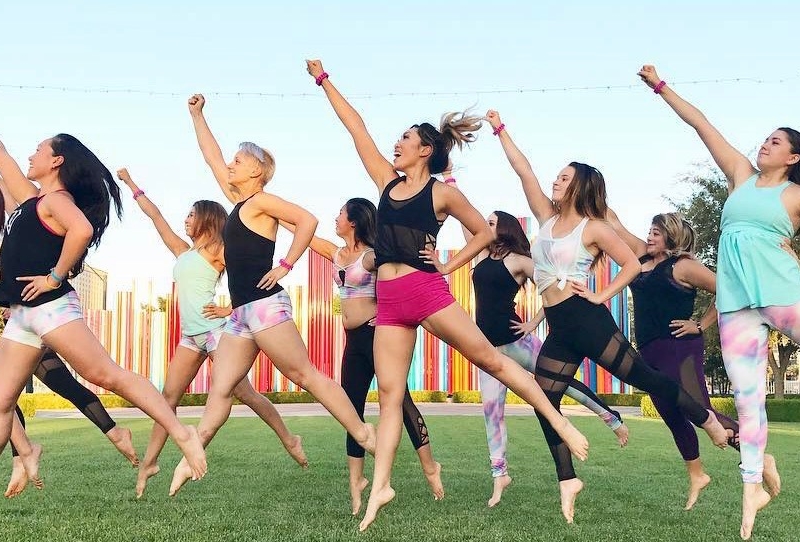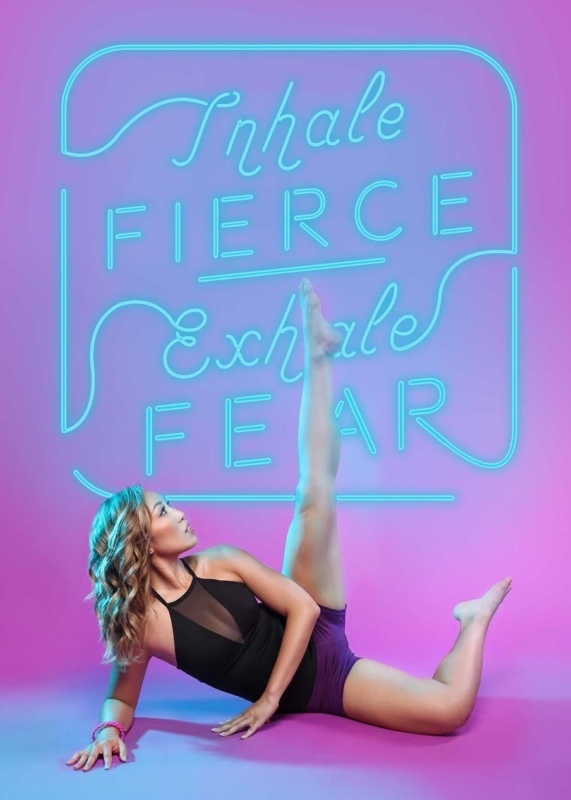Nine years ago, Cassey Ho quit the corporate job that was making her miserable and started following her passions: Pilates and fashion. Almost a decade later, she now has four million YouTube subscribers and is poised to launch the fourth collection in her activewear line, Popflex, this spring.

Since 2009, Ho has kept two things at the center of her business—listening to her audience and staying creative. She regularly asks viewers to comment on her workout videos with requests for body areas to target, and then will package it in new and quirky ways, like a Wonder Woman-themed workout. Similarly, when she noticed more and more body-shaming comments appearing on her videos, she channeled the negativity into one of her most personal (and most watched) videos, “The ‘Perfect’ Body,’” which reached more than 12 million views.
“When I started the YouTube channel, it was because I was moving from California to Boston and wanted my students to be able to keep following me,” Ho says of Blogilates’ early days. Now her unique mix of Pilates moves, pop playlists, and a perky personality can be seen around the globe, and her “POP Pilates” classes are licensed out to nearly 1,000 venues worldwide.
We asked Ho to share more of her creator story, including how she’s funded the company and developed a strong team culture.
How did you find the confidence to stick with your vision when you decided not to go to medical school or to quit your corporate job in order to teach Pilates full-time?
I’ve always been confident in myself because I have been confident in my skills. Even when people didn’t believe in me, I knew I would figure it out and be successful one day. I just kept working on my skills. It’s not about being better than anyone else. Put your head down, work hard, and the facts will speak for themselves.
While you’ve said your parents didn’t initially agree with you leaving the med school path, how do you think being raised by immigrants contributed to your own entrepreneurial spirit?
Everything we go through makes us who we are. My parents came to this country, didn’t know the language, and worked in the face of discrimination. That drive is also in me. They’ve made me very conscious about spending my money smartly and making the most of my education. I put education at the forefront of what I was doing. But at some point, it became too much because it wasn’t the only thing that mattered.
How have you funded your company?
Growing up, I’ve always been entrepreneurial. In middle school, I started a cookie business by melting down Halloween candy and selling it to my friends and even teachers! I made some money that way, and so I’ve always had some money saved up. In college, I had printouts of e-books that people didn’t want to buy their own copies of. Probably illegal, but it helped me save up some money!
Then, when I made my first purchase of fabrics to make my first yoga bag, I went to the L.A. fashion district, bought bolts of fab for a discounted price, and found a manufacturer in Oakland by flipping through the physical yellow pages! That’s how we started. I never got an investment from anyone. I started with what I had and built it from there. I grew the way I knew how to.
Who was your first employee?
Unofficially, my parents. They let me use their garage, which then expanded to the living room, the family room, and the kitchen before we got our own space.
My business partner—now fiancé—Sam Livits was my first employee. Since we were small, he did everything. He helped me film the very first video. We used a tiny camcorder and the sound is terrible. That was his first duty, but now what he does is negotiate brand deals and manage e-commerce and technical stuff on our site.

After establishing a following for your fitness videos, how did that translate to customers for your activewear brand?
As the YouTube channel started to grow, I got an audience who trusted me. It’s really important that your fans know you and they can trust that you wouldn’t screw them over. It gives you a marketing power that is so unique. When I did launch my first T-shirts, they sold out in a minute. Then they started asking for leggings. I was inspired by what the audience asked for and meshed that with my creativity.
It can be difficult for scrappy, ambitious entrepreneurs to give up control after wearing all the hats in their business. How have you dealt with that as your team has grown?
That’s something that I’m learning how to handle better. My best advice for that is to hire people who are better than you at those certain things so you can feel comfortable giving up control. If you don’t hire someone better than you, you’ll always see the faults and it won’t be good for the business because you’ll always be checking their work. They need to impress you.
It’s really important that your fans know you and they can trust that you wouldn’t screw them over. It gives you a marketing power that is so unique.
How big is your team now?
We have 10 people, including the people in the creative office in L.A. and shipping in Northern California. We’re hiring all the time because we’re drowning in work.
I found that has been one of the most difficult things—finding people that align with your vision and personalities that can help you build that solid culture.
How would you define the Blogilates culture?
Our culture is happy, positive, very encouraging. Basically, who I would like to hang out with. All of us work really hard and are really creative. During our interview process, we try to do tests to make sure we all can work together. Talent is important, but not as important as being able to let your ego go and try the best you can to get the results.
If you don’t hire someone better than you, you’ll always see the faults and you’ll always be checking their work.
Who do you turn to for advice on how to create culture?
I talk to fellow CEOs and businesswomen about culture and hiring all the time. I have a core group of YouTube friends I talk to, including Lindsey Stirling, Rosanna Pansino, Lilly Singh, iJustine, and Payal Kadakia of Classpass. The more I talk to people, the more I feel OK with the problems I’m having. When culture isn’t going right, it eats at my heart. It’s really good to know that it may not always be my fault.
What areas are you hoping to expand into in 2018?
We’re trying to grow our wholesale business. We haven’t tapped into this yet because we have an audience already who will buy our product. To be honest, I’m not totally versed in this. It will be fun to learn. And we’ll definitely need to hire for that.
From the beginning, fashion has been part of the business, starting with you designing yoga bags while you taught Pilates full-time. How much of your business is the fashion component now?
It’s the biggest part of our business. Merchandise, in general, is the biggest part. Stationary, water bottles—everyone wants a piece of the brand and the story. That’s something special that we have.
The personal touch is the reason the brand is what it is today. You can see that even with the YouTube videos, where I’m talking about nails and shopping. That may not add to the workout, but it brings you closer. People trust people, not brands. It’s important to consistently be transparent and be honest.
Where do you get inspiration for your fashion and fitness?
I always ask fans what they’re looking for. I do research on colors I think will be hot. We don’t subscribe to trend reports. I just go with, I like stars, so let’s go with it. So far it’s worked. If you have a story behind what you’re sharing, people will respond to it.

What’s a recent example of producing something based on requests from followers?
One of our hottest selling products is our Fit Planner. We just sold out of the 2018 edition. That started five years ago because people kept asking for a way to be organized and fit. Over time, we’ve created [better and better versions] of these journals. This year had the best design and most positive response to it.
You’re getting married this year. With these big personal changes, do you imagine your business changing along with you?
I do. In terms of product range, I see it changing. Leading up to the wedding, I’ll do a bridal boot camp. I wouldn’t feel good doing that unless I was actually getting married. Then maybe later I’ll be making fitness clothes for babies! Life is exciting, and we should keep evolving and sharing with people as it changes.
What are the two key traits that have contributed to your success?
My ability to be creative in problem-solving and my attitude of never giving up.







